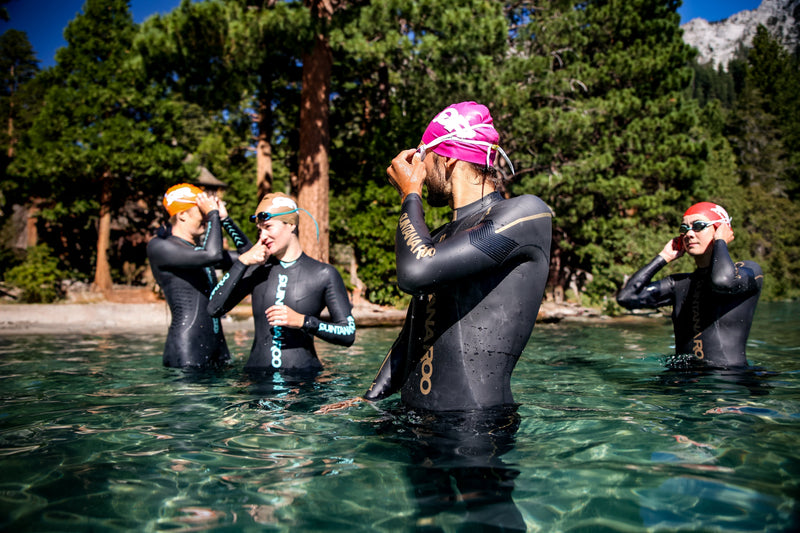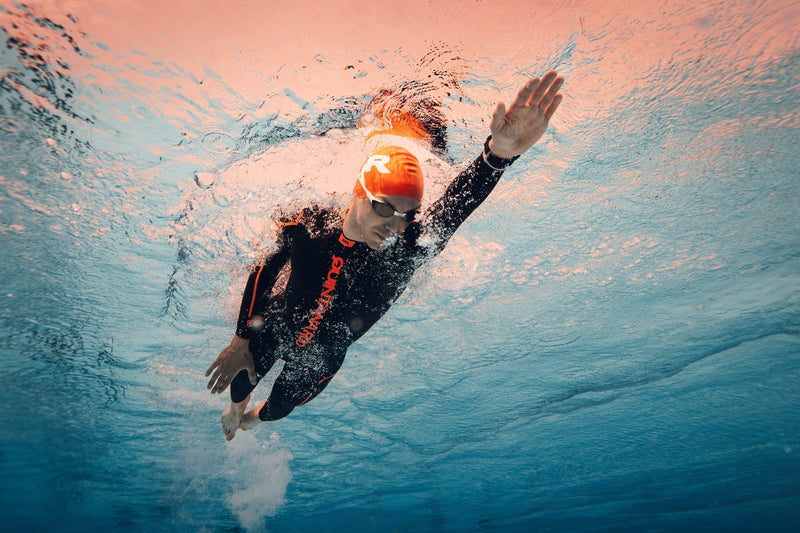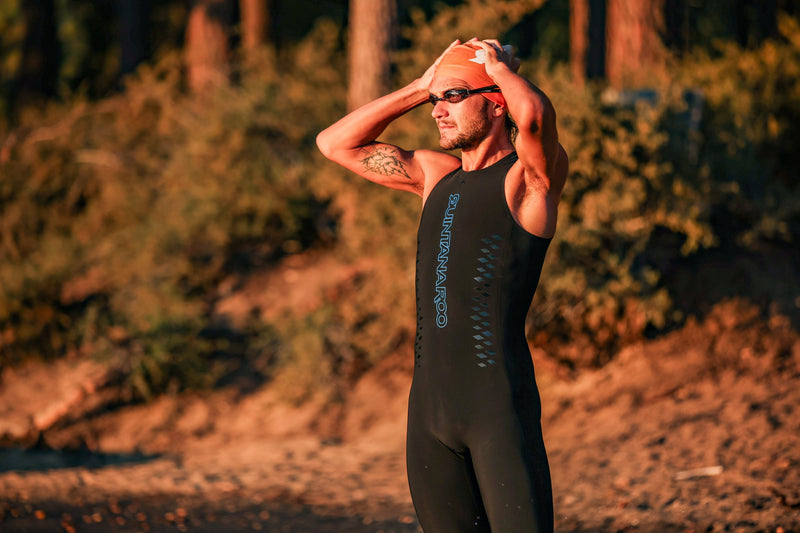10 TOP TIPS FOR TRIATHLON WETSUIT CARE

Treat your wetsuit right, and it’ll treat you right! A neoprene wetsuit is a pretty simple thing, but it provides so many benefits. From warmth to buoyancy to that sweet, sweet speed on race day, a wetsuit is a valuable and essential tool for triathletes, and it requires a bit of TLC to ensure it continues providing all those amazing benefits.
So, what does wetsuit care look like? Hanging it on your rearview mirror after the race and driving home with it flying in the breeze ain't it. (Yep, we've seen that.) We put together our 10 top tips to keep your wetsuit in great shape and ready to perform in your next race.
Shop Wetsuits1. Wet Your Wetsuit Before Use
While neoprene is closed-cell and doesn’t absorb water (that’s why it floats!), the jersey (the fabric backing that makes up the inside of the wetsuit) can absorb water like a sponge. In turn, it gets more pliable when wetted. Before getting your suit on for the first time in the spring, or after any lengthy dry spell, we always encourage you to dunk it in the sink or bath, and let the suit soak up a bit of hydration, before you get it wet in the lake or ocean for real.
Let those pores and cells get full and pliable. Even if it’s dried shortly after, the suit actually becomes a bit more flexible than before, which makes getting the suit on a bit easier, and gives you all the flexibility your Quintana Roo wetsuit is known for.

2. Rinse Your Wetsuit After Use
We’ll preface this important one with a legacy story from the inventor of the triathlon wetsuit, Dan Empfield. The story? He wanted Quintana Roo customers to feel safe with their purchase and had a no-fault return policy. That policy was pretty uneventful until one customer returned their wetsuit to the QR office for an exchange. The suit was a giant, amalgamated ball of rubber. Turns out, putting a rubber-based wetsuit in the dryer is a terrible idea; it melts.
DO NOT do that. But we do want to wash out our wetsuit. It's pretty simple: rinse your Quintana Roo wetsuit with cold, fresh water as soon as you can after your swim. Your wetsuit neoprene doesn't need much else than that. That means no washing machine, and no hot water. It doesn't need detergent or fabric softener. Bleach will certainly degrade it as well.
Top rinsing tips? Turn your suit inside out and give it a rinse from a hose, or hold it in front of the showerhead, or give it a few dunks in the bath or sink. This not only helps get rid of your own body’s grime, like sweat, sunscreen, and Bodyglide, but it also gets rid of things in the water (or on the shore) like salt, algae, sand, dirt, etc. These are all things that can make your suit degrade. A simple rinse, inside and out, will help add life to your wetsuit.
3. Don’t Pee in Your Wetsuit!
Okay, sure, there are extenuating circumstances when you might pee in your wetsuit (you’re nervous pre-race and it’s ice cold out there—a little warmth doesn’t hurt!). However, we shouldn't have to say it: let’s try to minimize peeing in your wetsuit. Urine doesn't necessarily degrade the rubber. However, it does make things… a little funky.
If you aren't terribly religious about rinsing out your suit after a race or open water swim, the scent could be a little alarming, especially if your suit sits in a hot car for a few hours after the swim. If you do pee in the suit, be sure to give it a good freshwater rinse immediately afterwards. This is a situation where it might also be worth using a wetsuit shampoo.
4. Dry Your Wetsuit in the Shade
Ultraviolet rays from the sun do a number on neoprene, as well as the flexible jersey and seams on the inside that hold the whole thing together. When a wetsuit has been exposed to too much sun, in even one season, it can become susceptible to “dry rot,” where the rubber loses its elasticity, becomes brittle, and even breaks into pieces.
We do recommend letting your cleaned wetsuit hang-dry, inside-out, in the open air, or in a dry environment. I use the showerhead in the bathroom if it’s a misty or rainy day. However, avoid letting that drying happen in the direct sunlight.
5. Pinch, Then Pull, and Keep Your Nails Clipped

Tears are the most common way a triathlon wetsuit gets damaged. While they are designed for speed, that smooth, slick skin is also very susceptible to tears. This typically happens before workouts or before a race, when you're pulling your wetsuit on; tugging at the calves, thighs, and hips puts a lot of focal pressure on the suit while you're pulling. Digging with your fingers invariably puts your fingernails into the rubber and can cause that dreaded tear.
Our tip? Pinch, then pull. Instead of digging your fingers in, we recommend pinching your thumb and side of your forefinger to grab a handful of rubber to pull the suit up. Doing so helps distribute the pulling load and keeps you from digging those sharp fingers into the rubber. A bit of body English and segmented pulling in segmented bunches (first from the calves, then up the thighs, then up the hips) allows you to get the lower body of the suit snugly into the crotch. Getting the upper body is a bit easier. Again, use the pinch-and-pull method, and you’ll reduce the chance of those dreaded tears.
6. Use Wetsuit Glue
Let's say you do get a small fingernail tear. It may not necessarily be time for a new wetsuit quite yet. A dab of wetsuit glue will help keep things rolling in a pinch and prevent that small tear from becoming a bigger one.
7. Use Neoprene-Friendly Lubricant

Nobody likes the dreaded “neck rubbies.” Rubbies, triathlon hickies, whatever you call them, neck chafing sucks. Depending on the wetsuit and how you hold your neck while breathing and sighting, they’re simply hard to avoid.
The best way to keep them at bay is by using a lubricant that relieves a bit of friction but doesn’t degrade the rubber. That means staying away from Vaseline. While it may be easy access in your bathroom cupboard, it’s petroleum-based, which has hydrocarbons that break down rubber, making it inelastic and brittle.
Luckily, there are plenty of safe alternatives. Products on the market from Body Glide, TriSlide, and GearAid provide that needed anti-chafing lubrication, while being safe on your wetsuit.
8. Use Plastic Bags or Socks
Use a bit of frictionless aid when putting your wetsuit on in the form of… a grocery bag?
Yep. Often, a bit of rush to get down to the swim start can lead to some hasty tugging and pulling, and the inevitable rip. One tip is to pack either a pair of socks or plastic grocery bags in with your wetsuit. (We provide special gloves with our wetsuits for this purpose, but socks and bags work in a pinch!) Putting the socks or plastic bags on your feet when putting them into the wetsuit legs provides a smooth, dry surface for the wetsuit to slide over (especially if you’re already wet or sweating from your pre-race warm-ups or good ‘ol nerves).
Once you’ve used the plastic bag or socks to get your wetsuit legs up with ease, use it on each of your hands to, one at a time, slide your arms through the upper half of the suit to help get your hands and wrists easily into the suit.
9. Put Your Name on It
One thing all triathlon wetsuits have in common is their color: they're all black. Being able to tell your Quintana wetsuit from the person next to you is helpful, especially when athletes are a bit discombobulated after the race, packing up all their gear to take home. Sometimes, the wrong wetsuit gets grabbed.
One way to ensure that doesn't happen is to put your name on the inside of the suit. A silver ink pen with your name and phone number ensures you're taking your own suit home, and can help someone who may have accidentally grabbed your suit get it back to you.
10. Store Your Suit Dry
Is open water swim season over for you? Dry your wetsuit properly (we definitely don’t want funky mold!) and put it away safely so it’s ready for action next season. We suggest either hanging it on a wide hanger or folding it up and putting it away in the Quintana Roo Dry Bag included with every wetsuit. It’ll then be ready for action next year!
Shop Wetsuits


